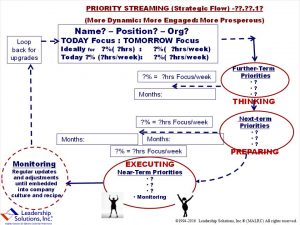by Peter A. Arthur-Smith, Leadership Solutions, Inc.®
“He’s a guy that can set a vision and get an entire organization and group of people to believe in it, pull in the same direction, and be committed to accomplishing it,” said Chris Antonetti, President of Cleveland Indians baseball team – NY Times article October 2016 entitled; ‘Cleveland, a School for Executives, Faces a Top Alumnus.’
 |
Antonetti was referring to his former boss, Mark Shapiro, who is now the President and CEO of the Toronto Blue Jays. Cleveland and Toronto are to meet for their first game in a best of seven, American League Championship series on October 14th, 2016.
By the time you get to read this article, you will know the outcome of the series – Shapiro’s former leadership and player teams up against his new ones. He joined Toronto
12 months ago after spending 24 seasons at Cleveland, where he worked his way up through the ranks. He was in Cleveland’s General Manager spot for 14 years before making the move.
‘If you need to make a hire in baseball operations – the secret has long been out – look for Cleveland on a resume,’ espoused the article. It went on to list 10 baseball executive names, who have been through the ‘Cleveland School of Executives,’ and are now either still leading the Indians or in influential positions elsewhere in sports.
Without probably realizing it, Shapiro has clearly adopted the same five enlightened leadership phases that Leadership Solutions favors. Such as:
» Enlightened Pathway – “he can set a vision”
» Enlightened People Motivation – “get a group of people to believe in it”
» Enlightened Teamwork – “pull in the same direction”
» Enlightened Momentum Building – “be committed to accomplishing it”
(Note: Decision Clarity – The starting point of enlightened leadership; has also to be in Shapiro’s personal armory as he has won the undoubted respect of those around him.)
But coming back to the title of this article – “Sustaining momentum, by sustaining focus:” Shapiro clearly excels in this area. Cleveland has, by necessity, been one of the smaller budget teams during recent years. Once it was in the top three, but changes in the city’s economic situation has meant a lot of belt tightening. Shapiro needed to handle that in a highly focused manner. Strategies to reflect the team’s modest revenues, trading away top talent to bring in cheaper players with potential, and constant professional development to bring along young executives as leaders. All three are axiomatic in building a successful organization: Compelling Strategy, Talented People and Effective Leadership.
More important has been his absolute focus – not ‘control,’ as traditional managers are apt to do. Leaders, on the other hand, apply focus once their strategy is set. By keeping their people locked into a compelling vision – or enlightened pathway – they draw their teams forward with an enlightened magnetic force, rather than the typical and expensive “push and drive” formula used by traditional managers. Leadership continuously orchestrates a motivated enterprise until the vision is surpassed – not just the next quarter, or the next one, but perhaps in 3-5 years. There are those who have harsh words for organizations that limp from quarter to quarter…they’re usually the ones managed not led.
So many executives give up after a year or two. Not Shapiro, who endured many lean years in Cleveland to place the Indians on a firmer footing – considering their lean budgets and resources. The current Indian surge is benefitting from all that. It will be interesting to see if his successor, Antonetti, can sustain it.
Clearly, enlightened leaders have the capability to set the future pace – that pathway or vision – and instill the day-to-day, week-to-week, month-to-month, quarter-to-quarter focus to orchestrate everyone toward their end view. Priority Streaming is their talent, even if they don’t recognize it as such. They know the difference between what is today’s focus and what is tomorrow’s intentions when it comes prioritizing.
Shapiro knows what today represents – what’s going on this week, this month, this quarter. He’s aware of the near-term operational strategies that need to be implemented; plus the motivated people-staff necessary to accomplish those strategies. On top of that he’s committed to developing a pipeline of leaders around him; with a limited number of managers. (NOTE: Managers concentrate on systems and process, while leaders focus on people and progress.)
“Shapiro’s role within priority streaming is to view today as his focus on this year’s day-to-day operations.”
Shapiro’s role within priority streaming is to view today as this year’s day-to-day operations. But tomorrow is all about preparing strategies for next year (2017) and thinking about strategies for the following year (2018). In contrast, his player team-manager-coach would see today as this week and this month(October); whereas tomorrow is for preparing things for November and thinking over issues for the following month (December). You see: each leader level has its own discrete time zone – depending on whether it’s a more strategic or operational role – otherwise everyone would be treading on everyone else’s toes, metaphorically speaking.
 |
Priority streaming, once it is laid out in a pictogram format –see adjacent –enables leaders at all levels to observe where they are at a glance. Our minds can absorb a picture rapidly, whereas it takes much longer to read and absorb an article like this – proof of the differences between rational (wordy) minds and intuitive (pictorial) ones.
The adjacent pictogram clarifies the role and timelines in the rectangular box at the top. Then you’ll notice three ellipses:
» EXECUTING (Today) – Bullet point items for your near-term implementation, relative to the position’s timescale.
» PREPARING (Tomorrow) – Bullet point items for your next timescale window. Things that already need to be put into place for the next time period, ready for implementation.
» THINKING (Tomorrow) – Bullet point items for your next subsequent time period. Issues that need to be well thought out ahead of time, to encourage a smooth transition toward future events.
.
These are the things that Shapiro does, albeit subconsciously, to motivate his organization and ensure progress. He is constantly working at two levels: implementing today’s strategies, and preparing for and thinking about tomorrow’s strategies. Effective leaders become good at working on two planes and usually not at the same time. Contrary to popular belief, there’s no such thing as multi-tasking. To execute something properly, your mind is better suited to concentrating on one thing at the time. If you’re multi-tasking, you’re probably doing a pretty mediocre job at those tasks. Have you noticed with multi-taskers? They usually leave a trail of debris to be picked up afterward.
Don’t despair. You are able to consciously execute one project, while your subconscious intuitive mind is mulling over how you will prepare or think about issues for the future. This is what happens with effective leaders, but they’ve made a conscious decision to play it that way: setting aside discrete time for execution, preparing, thinking and monitoring. It’s rather like music sheet for a quartet of musicians. Each instrument has its own line of music. More often than not, one takes the lead over the other three at particular moments in time. Enlightened leaders’ minds work the same way.
So, become invested in priority streaming. It will enable you to ‘sustain momentum by sustaining focus.’ Once you’ve mastered it, you will potentially become a terrific leader: especially if you have strong people skills, too. (By the way, the Indians won the Division series. Maybe Toronto will become a tougher contender after Shapiro’s been on the job for another 12 months.)
To learn more about priority streaming, talk with:
